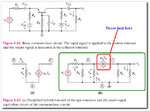samy555
Full Member level 4
Hello
From " Semiconductor Devices and Basic Applications " page 435, the book talks about:
Figure 6.63 (b) is the small signal equivalent circuit. Notice that the dependant current source directed from the collector to the emitter.
In other pdf file I found in:
**broken link removed**
On page 137 the followinf small signal equivalent circuit:
Here the dependant current source directed from the Base to the Collector.
My question: Is these MODELS are equivalent? If yes, how?
Thank you
From " Semiconductor Devices and Basic Applications " page 435, the book talks about:
Figure 6.63 (b) is the small signal equivalent circuit. Notice that the dependant current source directed from the collector to the emitter.
In other pdf file I found in:
**broken link removed**
On page 137 the followinf small signal equivalent circuit:
Here the dependant current source directed from the Base to the Collector.
My question: Is these MODELS are equivalent? If yes, how?
Thank you
Last edited:




